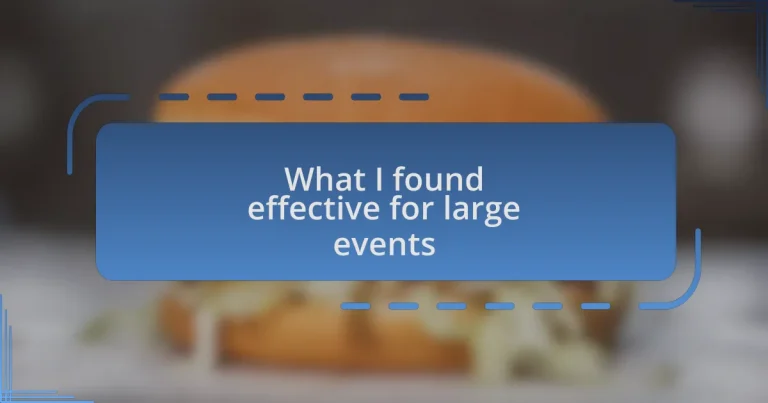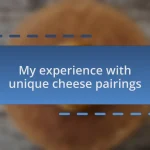Key takeaways:
- Gourmet burger trucks offer a unique and high-quality dining experience, catering to diverse tastes with innovative recipes and local ingredients.
- Effective menu planning and customer engagement at events can significantly enhance the overall experience, encouraging participation and fostering community.
- Key considerations for large events include food truck capacity, placement, and menu variety to meet guests’ dietary preferences and avoid logistical challenges.
- Personal connections and storytelling play a vital role in customer interactions, transforming simple transactions into memorable experiences.
Author: Olivia Hartwell
Bio: Olivia Hartwell is a contemporary fiction author known for her compelling narratives and vivid characterizations. With a background in literature and creative writing, she has a keen eye for detail and a passion for exploring the complexities of human relationships. Olivia’s debut novel, Whispers of the Heart, received critical acclaim and was nominated for several literary awards. When she’s not writing, she enjoys hiking in the mountains of Colorado and sipping artisanal coffee at local cafes. Olivia resides in Denver with her beloved rescue dog, Rosie.
Overview of Gourmet Burger Trucks
Gourmet burger trucks have transformed the way we think about street food. With their vibrant designs and mouthwatering aromas, these mobile kitchens create an inviting atmosphere that draws in hungry crowds. I remember my first encounter with a gourmet burger truck; the anticipation as I waited in line was palpable, and when I finally took my first bite, it was nothing short of euphoria.
These trucks offer a unique dining experience, combining convenience with high-quality ingredients and innovative recipes. Many burger trucks pride themselves on sourcing local, organic produce, allowing them to create dishes that are not just delicious but also support local farmers. Don’t you love the feeling of knowing you’re enjoying a meal that’s both tasty and sustainable?
In a world where fast food often lacks character, gourmet burger trucks stand out by telling a story with each burger they serve. They often experiment with toppings that go beyond the classics, like truffle aioli or roasted jalapeños. I find it thrilling to see how chefs push culinary boundaries in such a dynamic setting. Have you ever tried a burger topped with pineapple salsa? It’s a game changer!
Benefits of Using Food Trucks
Using food trucks at large events offers a blend of convenience and variety that you just can’t replicate with traditional catering. The ability to provide a wide range of gourmet burgers and sides from a single location means guests can choose exactly what they want without feeling constrained by a set menu. I remember attending a music festival where a food truck featured unique flavor combinations; the line was always buzzing with excitement as friends compared their culinary adventures.
Another significant benefit of food trucks is their mobility. They can set up anywhere, adapting to the flow of the event. I recall a wedding where the food truck followed the guests from the ceremony to the reception. It created an effortless experience for everyone, ensuring that the celebration continued without interruption, keeping the party spirit alive. Isn’t it wonderful to have food available exactly where the action is?
Lastly, food trucks often foster a sense of community. When people gather around a food truck, there’s a natural camaraderie that forms as they chat about their choices and share recommendations. I’ve seen friends bond over their first bites, exchanging smiles and nods of approval. Doesn’t it feel great to know that food can bring people together in such a delightful way?
Key Considerations for Large Events
When planning for large events, one key consideration is the capacity of the food truck. It’s essential to know how many guests you’ll be serving and whether the truck can handle that demand efficiently. I remember once at a community fair, the food truck we chose had a limited cooking setup, which led to long wait times. Guests were excited, but we quickly learned that preparation and staffing would’ve made all the difference in satisfaction.
Another important aspect is logistics, particularly regarding placement and accessibility. I’ve seen events where food trucks were tucked away, making them difficult to find amidst the crowd. Engaging with the event organizer early on about the ideal location can significantly enhance visibility and foot traffic. Have you ever felt disheartened when you realized there was delicious food available, but you simply couldn’t find it?
Lastly, think about the menu variety and how it aligns with your audience. When I hosted a large outdoor event, I focused on different dietary preferences—vegan, gluten-free, and meat options. It not only catered to everyone but sparked interesting conversations about food choices. It’s amazing how thoughtful planning can transform a meal into an experience. How often do we forget that the right culinary options elevate the entire atmosphere of an event?
Effective Menu Planning Strategies
Effective menu planning is crucial for large events, and I’ve always found that simplicity often reigns supreme. For instance, when I organized a festival, I streamlined the menu to include just a few core gourmet burger options. This not only reduced preparation time but also allowed my team to focus on quality, ensuring that every burger served was delicious. Have you ever had a meal that just left you wanting more, not because of what was lacking but because it was so satisfying?
Involving the audience in the planning process can be surprisingly effective. At a recent gathering, I created a poll to let attendees vote on which burger toppings they wanted. The engagement was incredible, and it made folks feel personally connected to the menu. This approach not only made them excited about the food but also ensured that we were serving what people truly desired. It’s reassuring to see how a little interaction can create a memorable experience around food.
I’ve also learned the value of themed menus tailored to the event’s spirit. During a local music festival, we incorporated a “Rock ‘n’ Roll” twist, featuring burgers named after famous bands. This playful touch sparked conversations and added to the festive vibe. How often do we overlook the emotional connections people have with food? I believe that a well-thought-out menu can transform what’s on the plate into a storyline everyone enjoys sharing.
Best Locations for Gourmet Trucks
When it comes to the best locations for gourmet food trucks, I’ve found that high foot traffic areas truly shine. For example, setting up near local breweries or popular parks during the weekends tends to draw in crowds looking for a tasty bite alongside their leisure activities. Have you ever noticed how a sizzling burger can transform a casual day out into something extraordinary?
I also believe that events tied to thematic gatherings or festivals provide excellent opportunities for gourmet trucks. I vividly recall parking our burger truck at a local arts and crafts fair, where the vibrant atmosphere combined with artistic displays made our food irresistible to attendees. People craved not just the burgers but the entire experience—the smell, the flavors, the ambiance. It’s fascinating how pairing great food with the right event can create an unforgettable memory, don’t you think?
Alternatively, I’ve seen incredible success with private events like weddings or corporate gatherings. One time, a couple opted for a gourmet burger bar at their reception instead of a traditional sit-down dinner, and it became the highlight of the evening. Guests were delighted to customize their burgers while mingling, which added an interactive element that a typical buffet wouldn’t have achieved. Isn’t it remarkable how personalized experiences can elevate an occasion?
Customer Engagement Techniques
Engaging customers at large events goes beyond just serving food; it’s about creating a memorable experience. I often use social media to connect with event-goers. For instance, at a summer festival, I encouraged patrons to share their burger creations on Instagram with a special hashtag. The response was incredible—seeing our food shared by excited customers gave the whole team a boost and made attendees feel part of a larger community. Have you ever felt more connected when your experiences are shared online?
Another effective technique I’ve found is providing interactive elements that draw customers in. At one event, I set up a toppings bar where guests could customize their burgers. As they mixed and matched ingredients, I chatted with them about their favorite combos. It was a hit! This not only made the experience unique but also fostered conversation. Who wouldn’t want to talk about that delicious creation they just crafted?
Additionally, I focus on gathering feedback in real-time. After serving, I might ask customers directly about their experience or if they enjoyed a certain burger. Once, at a local fair, a family shared their thoughts on a new spicy burger I was testing. Their enthusiasm and suggestions were invaluable, helping me refine my menu. How can you improve if you’re not hearing directly from those who matter most—your customers?
Personal Experience and Lessons Learned
The learning curve at large events has been steep yet rewarding. I remember one bustling food truck rally where I underestimated the demand for our signature gourmet burgers. We quickly ran out of supplies, which was disappointing not only for the customers but also for me personally. It taught me the importance of thorough preparation and forecasting demand. Have you ever faced a situation where a lack of planning led to lost opportunities?
Another valuable lesson was the significance of building a strong team. During one particular event, I found myself overwhelmed by the crowd. I relied on my staff, who were not just employees but a community. They jumped in without hesitation, ensuring our customers received the same quality service. It was a reminder that teamwork is essential in high-pressure situations. Who else has experienced the empowerment that comes from working together toward a common goal?
I’ve also discovered how impactful storytelling can be in customer interactions. One hot afternoon, I shared the inspiration behind our gourmet burger recipes with a curious guest. Just that small connection transformed an ordinary sale into an engaging moment. The customer left not just with food but with a story to tell. How often do we overlook the power of storytelling in making lasting impressions?


